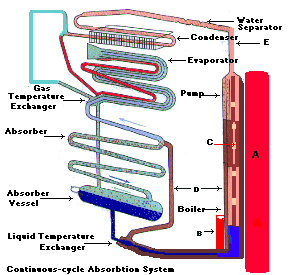

The continuous-cycle absorption cooling unit is operated by the application of a limited amount of heat. This heat is furnished by gas, electricity, or kerosene. No moving parts are employed.
The unit consists of four main parts: the boiler, condenser, evaporator and the absorber. When the unit operates on kerosene or gas, the heat is supplied by a burner. This element is fitted underneath the central tube (A). When operating on electricity, the heat is supplied by an element inserted in the pocket (B).
The unit charge consists of a quantity of ammonia, water, and hydrogen. These are at a sufficient pressure to condense ammonia at room temperature. When heat is supplied to the boiler system, bubbles of ammonia gas are produced. They rise and carry with them quantities of weak ammonia solution through the siphon pump (C). This weak solution passes into tube (D), while the ammonia vapor passes into the vapor pipe (E) and on to the water separator. Here any water vapor is condensed and runs back into the boiler system, leaving the dry ammonia vapor to pass to the condenser. Air circulating over the fins of the condenser removes heat from the ammonia vapor. It condenses into liquid ammonia and then flows into the evaporator.
The evaporator is supplied with hydrogen. The hydrogen passes across the surface of the ammonia. It lowers the ammonia vapor pressure enough to allow the liquid ammonia to evaporate. The evaporation of the ammonia extracts heat from the evaporator. This, in turn, extracts heat from the food storage space, lowering the temperature inside the refrigerator.
The mixture of ammonia and hydrogen vapor passes from the evaporator to the absorber. A continuous trickle of weak ammonia solution enters the upper portion of the absorber. It is fed by gravity from the tube (D). This weak solution flows down through the absorber. It comes into contact with the mixed ammonia and hydrogen gases. This readily absorbs the ammonia from the mixture. The hydrogen is free to rise through the absorber coil and to return to the evaporator. The hydrogen circulates continuously between the absorber and the evaporator.
The strong ammonia solution produced in the absorber flows down to the absorber vessel. It passes on to the boiler system, thus completing the full cycle of operation. This cycle operates continuously as long as the boiler is heated. A thermostat which controls the heat source regulates the temperature of the refrigerated space. Since the refrigerant is ammonia, it can produce quite low temperatures. Except for the thermostatic controls, there are no moving parts.
Source: http://www.nh3tech.org/abs.html